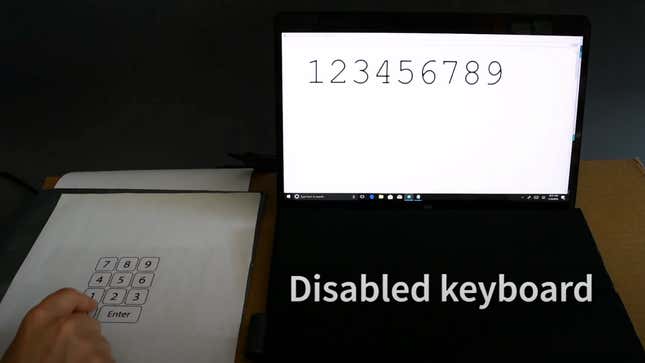
One day in the perhaps not-so-distant future, you’ll be able to interact with your tablet, phone, or computer using a regular ole sheet of notebook paper.
Engineers at Purdue University have created a printing process by which you can coat paper or cardboard with “highly fluorinated molecules.” This then makes the coated paper dust, oil, and water-repellent, meaning you can then print multiple circuit layers onto the paper without smudging the ink. According to a paper the engineers published in Nano Energy, these “triboelectric areas” are then capable of “self-powered Bluetooth wireless communication.” That’s science-speak to say that paper printed and coated in this way doesn’t require external batteries as it generates electricity from contact with a user’s finger.
You can see a demonstration of how the tech works in these two videos. In the first video, Purdue engineers have a paper keypad that’s been treated with the aforementioned “omniphobic” coating. The paper keypad is then doused in some neon-green solution. In the second video, you can then see a person use the paper keypad to actually type on a laptop with a disabled keyboard.
In a third video, Purdue’s team printed a forward, back, mute, and volume bar on the back of a piece of paper. In it, you can see someone controlling audio playback by dragging their finger along the volume bar, as well as skipping forward and back in the music queue—some real David Blaine street magic-level shit.
While the tech itself is pretty cool, another neat aspect is that because it works on paper and cardboard, it would be relatively inexpensive, flexible, and quick to make. That makes it a good candidate for things like smart packaging.
“I envision this technology to facilitate the user interaction with food packaging, to verify if the food is safe to be consumed, or enabling users to sign the package that arrives at home by dragging their finger over the box to properly identify themselves as the owner of the package,” Ramses Martinez, an assistant professor at Purdue’s School of Industrial Engineering and one of the authors of the paper, said in a statement.
This isn’t the first time engineers have figured out novel uses for paper in electronics. A few months ago, researchers at the University of Missouri also created a paper-and-pencil medical wearable that could monitor things like heart rate, respiratory rate, glucose levels, body temperature, and sweat composition. In 2015, researchers from the University of Michigan created a stretchy conductor made of paper cut using the Japanese art of kirigami.
Purdue’s innovation is particularly interesting as it eliminates the need for external power sources, which makes applications like smart packaging less theoretical. That said, it’ll probably be a while before you can print your own paper Bluetooth keyboard.